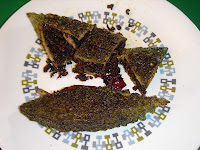Pasanda is a Mughlai dish which was prepared for the royal families. Traditionally it was prepared using only the best cuts of Lamb but these days one finds pasanda recipes with Chicken and even Prawns. I remember accompanying my father to the butcher, where my dad would order pasanda meat. The family butcher who knew my dad well for his finickiness would first show the meat cut before preparing. It looked the best, but remember I was only 7-8 years old and every piece which my dad approved would be the best! Once the meat pieces were approved the butcher would then slice the boneless meat into strips about ½ inch steaks and tenderise them first with the sharp end of the cleaver then the back of it. While he was preparing the meat my dad would tell me how delicate the process was, as while the butcher is beating the meat he at no point should cut it through. I think this tale was not only for me, but loud enough so that the butcher could hear it as well, so that he made no mistakes.
I have had pasanda in restaurants and have been disappointed as the meat is in no way tenderised. Here I will give you an old family recipe, hopefully you would like it and notice the difference. For preparation of the steaks I went to a butcher, who knew exactly how to prepare the pasanda meat, just like what I remember from my childhood days!
- Lamb Pasanda 750 gms (for pasanda we need boneless leg meat which is sliced into ¼ inch thick steaks. These are then flattened and beaten lightly with a meat cleaver, ensuring that the meat is not cut through, one could use the meat tenderising mallet)
- 1 ½ inch Cinnamon
- 10 Green Cardamon
- ½ tsf Peppercorns
- 12 Cloves
- ½ tsf Cumin seeds (Jeera)
- 2 Bay leaves
- Oil 4-5 tbsf
- 5 small Onions grated
- 1 bulb Garlic
- ½ tsf Poppy seeds (khas khas)
- 1 ½ tsf Salt (to taste)
- 2 tsf Chilli powder
- 3 tbsf Yogurt
Method:
 |
| Pasanda with all spices |
- Soak the Poppy seeds in small amount of water for 15 minutes.
- Grind the soaked Poppy seeds, ¼ tsf peppercorn, 1½ tsf salt and 6 garlic in a paste and then mix it with 3 tbsf of yogurt.
- Put the pasanda pieces in this marinade and leave it for 4 hours in the fridge.
- Grate the onions.
- Coarsely grind cinnamon stick, remaining peppercorns, cardamon and cloves (this is my version of garam masala).
- In a heavy wok heat the oil. When hot add my version of garam masala, cumin seeds and bay leaves. Let them splutter.
- Add onions and brown them.
- Add the pasanda with all marinade and mix well so that the whole yogurt mixes with the browned onions.
- Add chilli powder and mix. Fry the meat till slightly brown.
- Add 100 mls of water, bring it to a boil and lower the heat and let the meat cook for another hour stirring it from time to time. Keep checking the meat for readiness as different meat cuts have different cooking times. May need extra water if meat catches at the bottom. In the end the pasanda should have thick gravy and the meat should be tender almost breaking with a spoon.














